Atmospheric Circulation Drivers of Extreme High Water Level Events at Foggy Island Bay, Alaska
Abstract
:1. Introduction
2. Materials and Methods
3. Results
3.1. Local Impacts of Wind Events
3.2. Large-Scale Atmospheric Drivers
4. Discussion
5. Conclusions
Author Contributions
Funding
Institutional Review Board Statement
Informed Consent Statement
Data Availability Statement
Acknowledgments
Conflicts of Interest
References
- Bird, K.J.; Charpentier, R.R.; Gautier, D.L.; Houseknecht, D.W.; Klett, T.R.; Pitman, J.K.; Moore, T.E.; Schenk, C.J.; Tennyson, M.E.; Wandrey, C.J. Circum-Arctic Resource Appraisal: Estimates of Undiscovered Oil and Gas North of the Arctic Circle; USGS Fact Sheet 2008-3049; U.S. Geological Survey: Reston, VA, USA, 2008; pp. 1–4. [CrossRef] [Green Version]
- Bekryaev, R.V.; Polyakov, I.V.; Alexeev, V.A. Role of Polar Amplification in Long-Term Surface Air Temperature Variations and Modern Arctic Warming. J. Clim. 2010, 23, 3888–3906. [Google Scholar] [CrossRef]
- Serreze, M.C.; Barry, R.G. Processes and Impacts of Arctic Amplification: A Research Synthesis. Glob. Planet. Chang. 2011, 77, 85–96. [Google Scholar] [CrossRef]
- Terenzi, J.; Jorgenson, M.T.; Ely, C.R. Storm-Surge Flooding on the Yukon-Kuskokwim Delta, Alaska. Arctic 2014, 67, 360–374. [Google Scholar] [CrossRef]
- Sultan, N.J.; Braun, K.W.; Thieman, D.S.; Sampath, A. North Slope Trends in Sea Level, Storm Frequency, Duration and Intensity. In Proceedings of the SNAME 9th International Conference and Exhibition on Performance of Ships and Structures in Ice, Anchorage, AK, USA, 20–23 September 2010. [Google Scholar]
- Lantz, T.C.; Moffat, N.D.; Jones, B.M.; Chen, Q.; Tweedie, C.E. Mapping Exposure to Flooding in Three Coastal Communities on the North Slope of Alaska Using Airborne LiDAR. Coast. Manag. 2020, 48, 96–117. [Google Scholar] [CrossRef]
- Lynch, A.H.; Lestak, L.R.; Uotila, P.; Cassano, E.N.; Xie, L. A Factorial Analysis of Storm Surge Flooding in Barrow, Alaska. Mon. Weather Rev. 2008, 136, 898–912. [Google Scholar] [CrossRef]
- Irrgang, A.M.; Lantuit, H.; Manson, G.K.; Günther, F.; Grosse, G.; Overduin, P.P. Variability in Rates of Coastal Change Along the Yukon Coast, 1951 to 2015. J. Geophys. Res. Earth Surf. 2018, 123, 779–800. [Google Scholar] [CrossRef] [Green Version]
- Kowalik, Z. Storm Surges in the Beaufort and Chukchi Seas. J. Geophys. Res. 1984, 89, 10570. [Google Scholar] [CrossRef] [Green Version]
- Reimnitz, E.; Maurer, D.K. Effects of Storm Surges on the Beaufort Sea Coast, Northern Alaska. Arctic 1979, 32, 329–344. [Google Scholar] [CrossRef] [Green Version]
- Kim, J.; Murphy, E.; Nistor, I.; Ferguson, S.; Provan, M. Numerical Analysis of Storm Surges on Canada’s Western Arctic Coastline. J. Mar. Sci. Eng. 2021, 9, 326. [Google Scholar] [CrossRef]
- Walker, D.A.; Webber, P.J. Relationships of Soil Acidity and Air Temperature to the Wind and Vegetation at Prudhoe Bay, Alaska. Arctic 1979, 32, 224–236. [Google Scholar] [CrossRef]
- Overland, J.E. Meteorology of the Beaufort Sea. J. Geophys. Res. 2009, 114, C00A07. [Google Scholar] [CrossRef] [Green Version]
- Serreze, M.C.; Barrett, A.P. Characteristics of the Beaufort Sea High. J. Clim. 2011, 24, 159–182. [Google Scholar] [CrossRef] [Green Version]
- Bieniek, P.A.; Bhatt, U.S.; Walker, D.A.; Raynolds, M.K.; Comiso, J.C.; Epstein, H.E.; Pinzon, J.E.; Tucker, C.J.; Thoman, R.L.; Tran, H.; et al. Climate Drivers Linked to Changing Seasonality of Alaska Coastal Tundra Vegetation Productivity. Earth Interact. 2015, 19, 1–29. [Google Scholar] [CrossRef]
- Zhang, T.; Osterkamp, T.E.; Stamnes, K. Some Characteristics of the Climate in Northern Alaska, U.S.A. Arct. Alp. Res. 1996, 28, 509–518. [Google Scholar] [CrossRef]
- Kozo, T.L. Evidence for Sea Breezes on the Alaskan Beaufort Sea Coast. Geophys. Res. Lett. 1979, 6, 849–852. [Google Scholar] [CrossRef]
- Moritz, R.E. On a Possible Sea-Breeze Circulation near Barrow, Alaska. Arct. Alp. Res. 1977, 9, 427–431. [Google Scholar] [CrossRef]
- Walsh, J.E. Measurements of the Temperature, Wind, and Moisture Distribution across the Northern Coast of Alaska. Arct. Alp. Res. 1977, 9, 175–182. [Google Scholar] [CrossRef]
- Kenigson, J.S.; Timmermans, M.L. Arctic Cyclone Activity and the Beaufort High. J. Clim. 2021, 34, 4119–4127. [Google Scholar] [CrossRef]
- Stegall, S.T.; Zhang, J. Wind Field Climatology, Changes, and Extremes in the Chukchi-Beaufort Seas and Alaska North Slope during 1979–2009. J. Clim. 2012, 25, 8075–8089. [Google Scholar] [CrossRef]
- Baule, W.J.; Shulski, M.D. Climatology and Trends of Wind Speed in the Beaufort/Chukchi Sea Coastal Region from 1979 to 2009. Int. J. Climatol. 2014, 34, 2819–2833. [Google Scholar] [CrossRef]
- Rinke, A.; Maturilli, M.; Graham, R.M.; Matthes, H.; Handorf, D.; Cohen, L.; Hudson, S.R.; Moore, J.C. Extreme Cyclone Events in the Arctic: Wintertime Variability and Trends. Environ. Res. Lett. 2017, 12, 094006. [Google Scholar] [CrossRef]
- Sepp, M.; Jaagus, J. Changes in the Activity and Tracks of Arctic Cyclones. Clim. Chang. 2011, 105, 577–595. [Google Scholar] [CrossRef]
- Ballinger, T.J.; Walsh, J.E.; Bhatt, U.S.; Bieniek, P.A.; Tschudi, M.A.; Brettschneider, B.; Eicken, H.; Mahoney, A.R.; Richter-Menge, J.; Shapiro, L.H. Unusual West Arctic Storm Activity During Winter 2020: Another Collapse of the Beaufort High? Geophys. Res. Lett. 2021, 48, e2021GL092518. [Google Scholar] [CrossRef]
- Moore, G.W.K.; Schweiger, A.; Zhang, J.; Steele, M. Collapse of the 2017 Winter Beaufort High: A Response to Thinning Sea Ice? Geophys. Res. Lett. 2018, 45, 2860–2869. [Google Scholar] [CrossRef]
- Redilla, K.; Pearl, S.T.; Bieniek, P.A.; Walsh, J.E. Wind Climatology for Alaska: Historical and Future. Atmos. Clim. Sci. 2019, 09, 683–702. [Google Scholar] [CrossRef] [Green Version]
- Basu, S.; Walsh, J.E. Climatological Characteristics of Historical and Future High-Wind Events in Alaska. Atmos. Clim. Sci. 2018, 8, 373–394. [Google Scholar] [CrossRef] [Green Version]
- Walsh, J.E.; Bhatt, U.S.; Littell, J.S.; Leonawicz, M.; Lindgren, M.; Kurkowski, T.A.; Bieniek, P.A.; Thoman, R.; Gray, S.; Rupp, T.S. Downscaling of Climate Model Output for Alaskan Stakeholders. Environ. Model. Softw. 2018, 110, 38–51. [Google Scholar] [CrossRef]
- Skamarock, W.C.; Skamarock, W.C.; Klemp, J.B.; Dudhia, J.; Gill, D.O.; Barker, D.M.; Wang, W.; Powers, J.G. A Description of the Advanced Research WRF Version 3; NCAR Technical Note -475+STR; National Center for Atmospheric Research: Boulder, CO, USA, 2008. [Google Scholar]
- Bieniek, P.A.; Bhatt, U.S.; Walsh, J.E.; Rupp, T.S.; Zhang, J.; Krieger, J.R.; Lader, R. Dynamical Downscaling of ERA-Interim Temperature and Precipitation for Alaska. J. Appl. Meteorol. Climatol. 2016, 55, 635–654. [Google Scholar] [CrossRef]
- Lader, R.; Walsh, J.E.; Bhatt, U.S.; Bieniek, P.A. Projections of Twenty-First-Century Climate Extremes for Alaska via Dynamical Downscaling and Quantile Mapping. J. Appl. Meteorol. Climatol. 2017, 56, 2393–2409. [Google Scholar] [CrossRef]
- Lader, R.; Walsh, J.E.; Bhatt, U.S.; Bieniek, P.A. Agro-Climate Projections for a Warming Alaska. Earth Interact. 2018, 22, 1–24. [Google Scholar] [CrossRef]
- Morrison, H.; Thompson, G.; Tatarskii, V. Impact of Cloud Microphysics on the Development of Trailing Stratiform Precipitation in a Simulated Squall Line: Comparison of One- and Two-Moment Schemes. Mon. Weather Rev. 2009, 137, 991–1007. [Google Scholar] [CrossRef] [Green Version]
- Iacono, M.J.; Delamere, J.S.; Mlawer, E.J.; Shephard, M.W.; Clough, S.A.; Collins, W.D. Radiative Forcing by Long‐Lived Greenhouse Gases: Calculations with the AER Radiative Transfer Models. J. Geophys. Res. 2008, 113, 13103. [Google Scholar] [CrossRef]
- Janjić, Z.I. The Step-Mountain Eta Coordinate Model: Further Developments of the Convection, Viscous Sublayer, and Turbulence Closure Schemes. Mon. Weather Rev. 1994, 122, 927–945. [Google Scholar] [CrossRef]
- Zhang, X.; Walsh, J.E.; Zhang, J.; Bhatt, U.S.; Ikeda, M. Climatology and Interannual Variability of Arctic Cyclone Activity: 1948–2002. J. Clim. 2004, 17, 2300–2317. [Google Scholar] [CrossRef]
- Liu, F.; Krieger, J.R.; Zhang, J. Toward Producing the Chukchi-Beaufort High-Resolution Atmospheric Reanalysis (CBHAR) via the WRFDA Data Assimilation System. Mon. Weather Rev. 2014, 142, 788–805. [Google Scholar] [CrossRef]
- Zhang, J.; Liu, F.; Tao, W.; Krieger, J.; Shulski, M.; Zhang, X. Mesoscale Climatology and Variation of Surface Winds over the Chukchi-Beaufort Coastal Areas. J. Clim. 2016, 29, 2721–2739. [Google Scholar] [CrossRef] [Green Version]
- Lund, I.A. Map-Pattern Classification by Statistical Methods. J. Appl. Meteorol. 1963, 2, 56–65. [Google Scholar] [CrossRef]
- Dee, D.P.; Uppala, S.M.; Simmons, A.J.; Berrisford, P.; Poli, P.; Kobayashi, S.; Andrae, U.; Balmaseda, M.A.; Balsamo, G.; Bauer, P.; et al. The ERA-Interim Reanalysis: Configuration and Performance of the Data Assimilation System. Q. J. R. Meteorol. Soc. 2011, 137, 553–597. [Google Scholar] [CrossRef]
- Tilburg, C.E.; Garvine, R.W. A Simple Model for Coastal Sea Level Prediction. Weather Forecast. 2004, 19, 511–519. [Google Scholar] [CrossRef]
- Danielson, S.L.; Hennon, T.D.; Hedstrom, K.S.; Pnyushkov, A.V.; Polyakov, I.V.; Carmack, E.; Filchuk, K.; Janout, M.; Makhotin, M.; Williams, W.J.; et al. Oceanic Routing of Wind-Sourced Energy Along the Arctic Continental Shelves. Front. Mar. Sci. 2020, 7, 509. [Google Scholar] [CrossRef]
- Moore, G.W.K.; Pickart, R.S. The Wrangel Island Polynya in Early Summer: Trends and Relationships to Other Polynyas and the Beaufort Sea High. Geophys. Res. Lett. 2012, 39, L05503. [Google Scholar] [CrossRef] [Green Version]
- Hudak, D.R.; Young, J.M.C. Storm Climatology of the Southern Beaufort Sea. Atmos. Ocean 2002, 40, 145–158. [Google Scholar] [CrossRef]
- Vessey, A.F.; Hodges, K.I.; Shaffrey, L.C.; Day, J.J. An Inter-Comparison of Arctic Synoptic Scale Storms between Four Global Reanalysis Datasets. Clim. Dyn. 2020, 54, 2777–2795. [Google Scholar] [CrossRef] [Green Version]
- Valkonen, E.; Cassano, J.; Cassano, E. Arctic Cyclones and Their Interactions With the Declining Sea Ice: A Recent Climatology. J. Geophys. Res. Atmos. 2021, 126, 1–35. [Google Scholar] [CrossRef]
- Walsh, J.E.; Ballinger, T.J.; Euskirchen, E.S.; Hanna, E.; Mård, J.; Overland, J.E.; Tangen, H.; Vihma, T. Extreme Weather and Climate Events in Northern Areas: A Review. Earth-Sci. Rev. 2020, 209, 103324. [Google Scholar] [CrossRef]
- De Boer, G.; Chapman, W.; Kay, J.E.; Medeiros, B.; Shupe, M.D.; Vavrus, S.; Walsh, J. A Characterization of the Present-Day Arctic Atmosphere in CCSM4. J. Clim. 2012, 25, 2676–2695. [Google Scholar] [CrossRef]
- Akperov, M.; Rinke, A.; Mokhov, I.I.; Semenov, V.A.; Parfenova, M.R.; Matthes, H.; Adakudlu, M.; Boberg, F.; Christensen, J.H.; Dembitskaya, M.A.; et al. Future Projections of Cyclone Activity in the Arctic for the 21st Century from Regional Climate Models (Arctic-CORDEX). Glob. Planet. Chang. 2019, 182, 103005. [Google Scholar] [CrossRef] [Green Version]
- Harvey, B.J.; Cook, P.; Shaffrey, L.C.; Schiemann, R. The Response of the Northern Hemisphere Storm Tracks and Jet Streams to Climate Change in the CMIP3, CMIP5, and CMIP6 Climate Models. J. Geophys. Res. Atmos. 2020, 125, e2020JD032701. [Google Scholar] [CrossRef]
- Casas-Prat, M.; Wang, X.L. Projections of Extreme Ocean Waves in the Arctic and Potential Implications for Coastal Inundation and Erosion. J. Geophys. Res. Ocean. 2020, 125, e2019JC015745. [Google Scholar] [CrossRef]
- Sweet, W.V.; Hamlington, B.D.; Kopp, R.E.; Weaver, C.P.; Barnard, P.L.; Bekaert, D.; Brooks, W.; Craghan, M.; Dusek, G.; Frederikse, T.; et al. Global and Regional Sea Level Rise Scenarios for the United States; NOAA Tech. Rep. NOS 01 ; National Oceanic and Atmospheric Administration: Silver Spring, MD, USA, 2022; 111p.
- Nederhoff, K.; Erikson, L.; Engelstad, A.; Bieniek, P.; Kasper, J. The Effect of Changing Sea Ice on Wave Climate Trends along Alaska’s Central Beaufort Sea Coast. Cryosphere 2022, 16, 1609–1629. [Google Scholar] [CrossRef]
- Reimnitz, E.; Maurer, D.K. Storm Surges in the Alaskan Beaufort Sea; US Geological Survey: Reston, VA, USA, 1978; Volume 78.

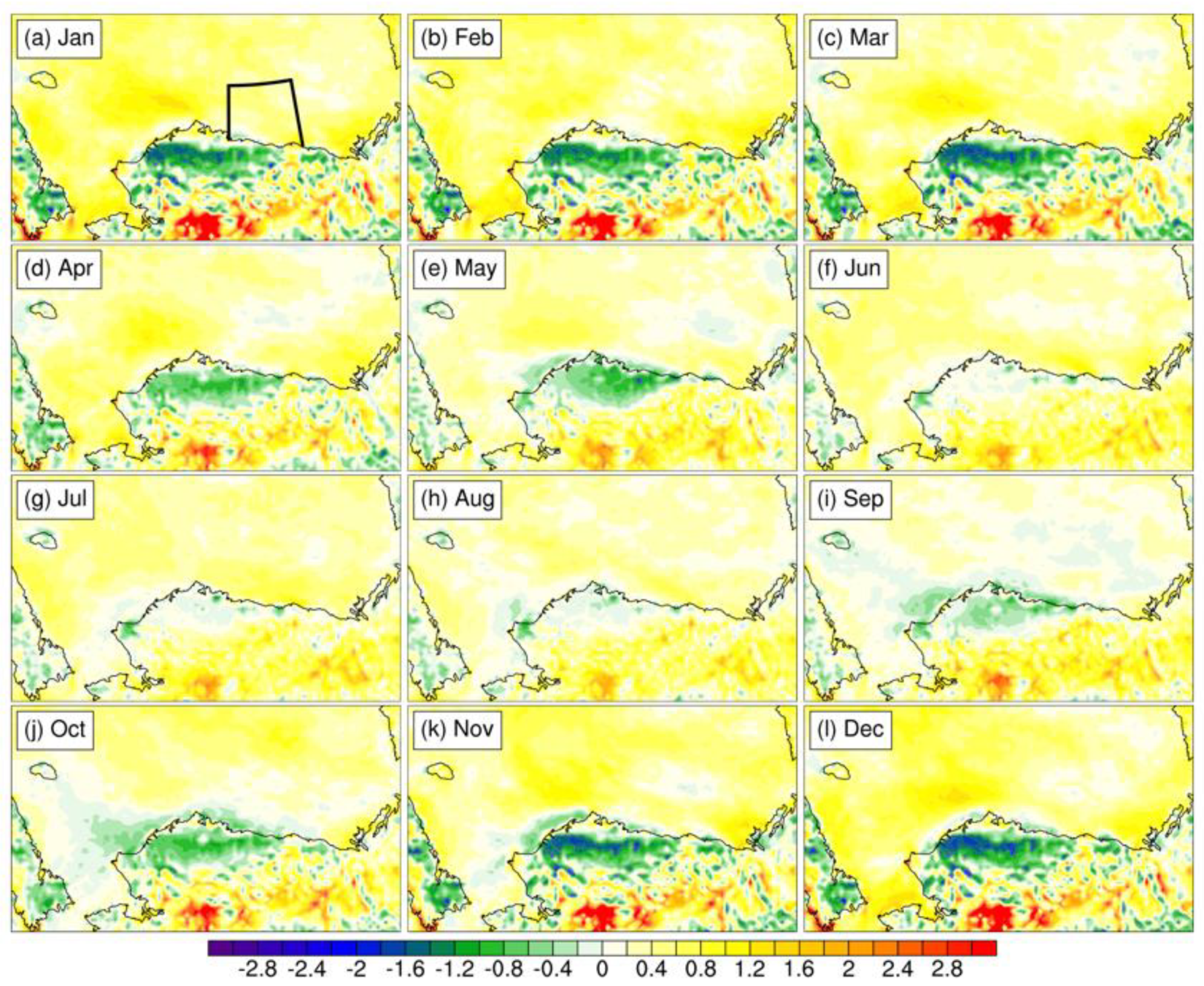

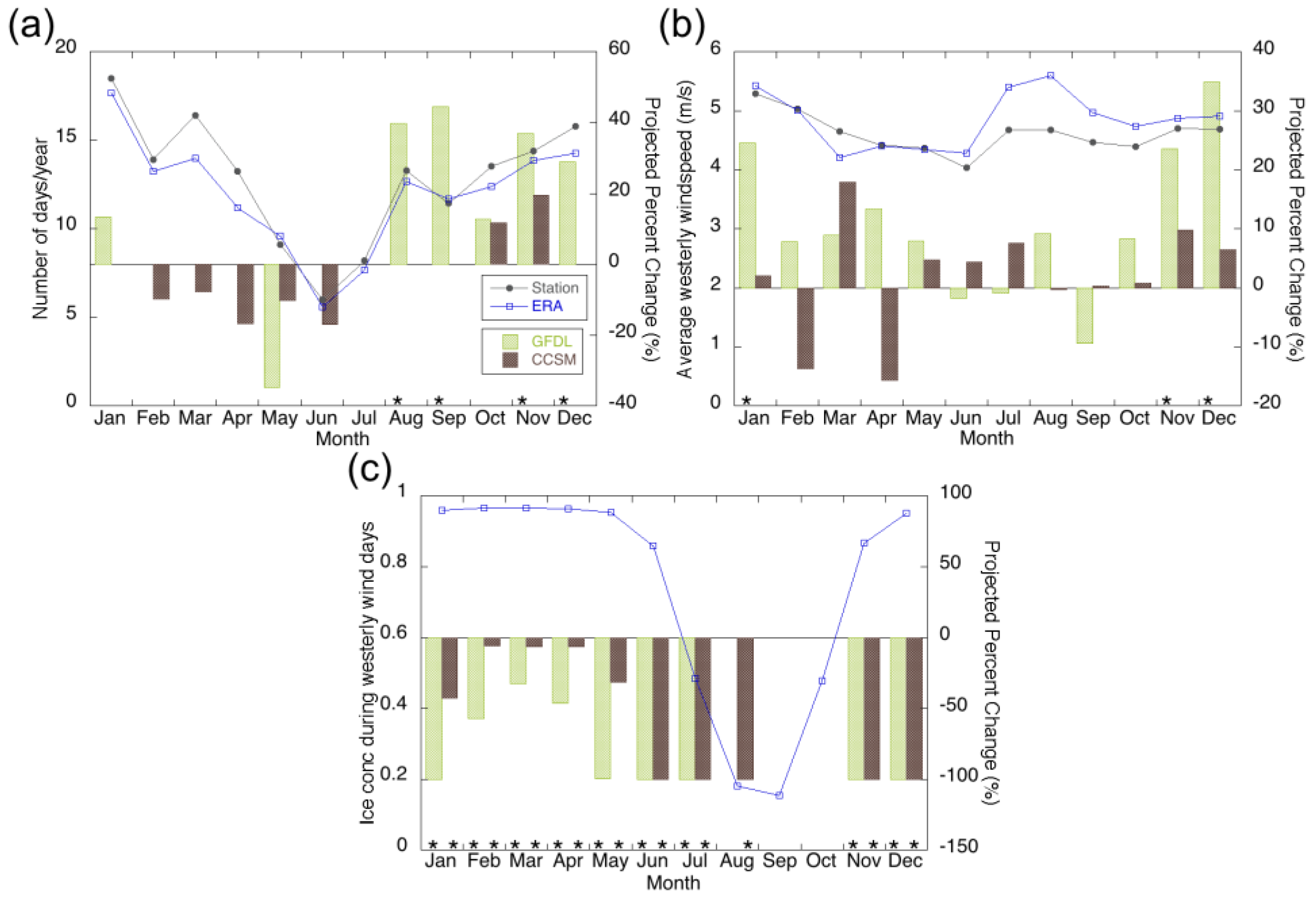

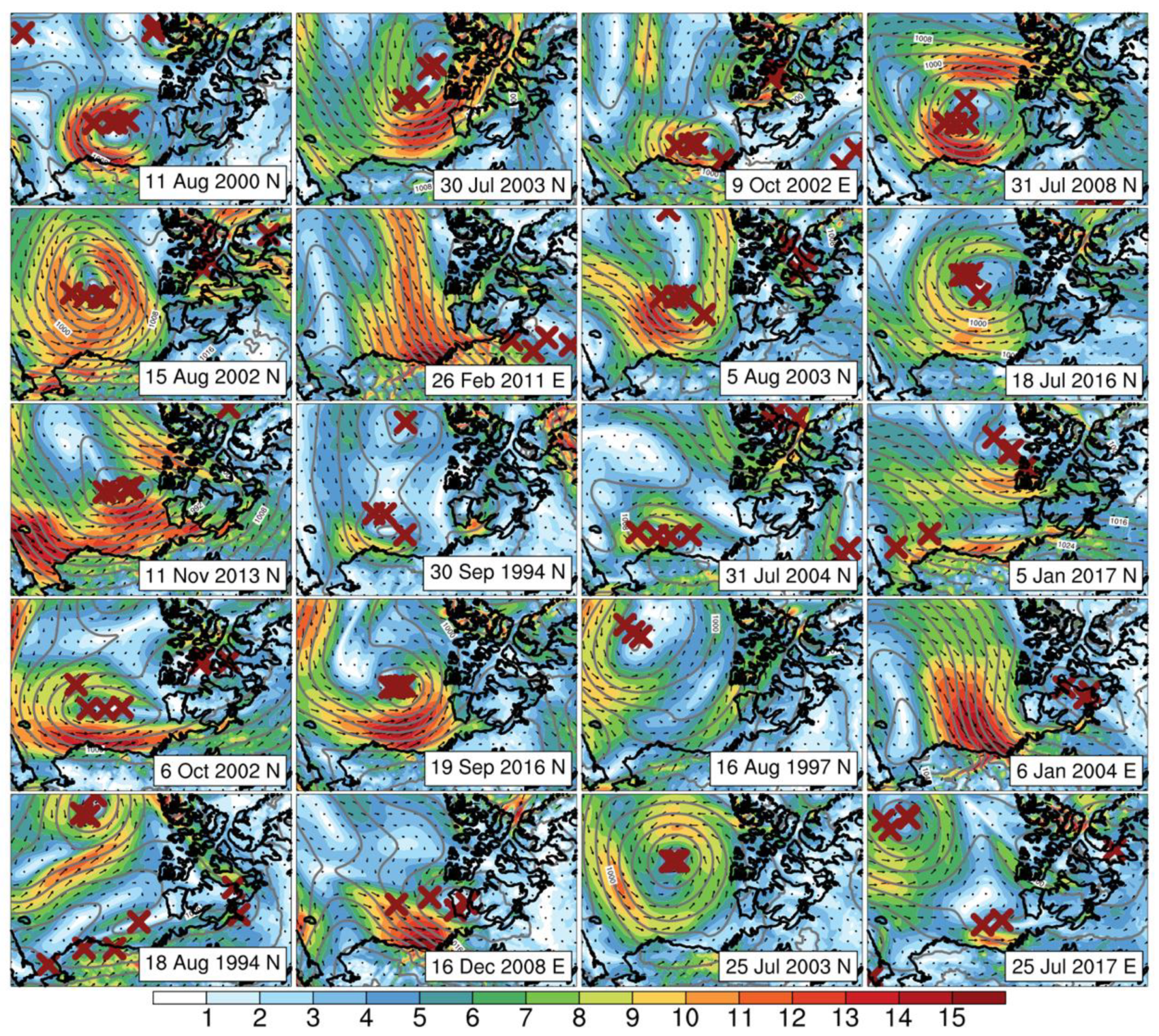
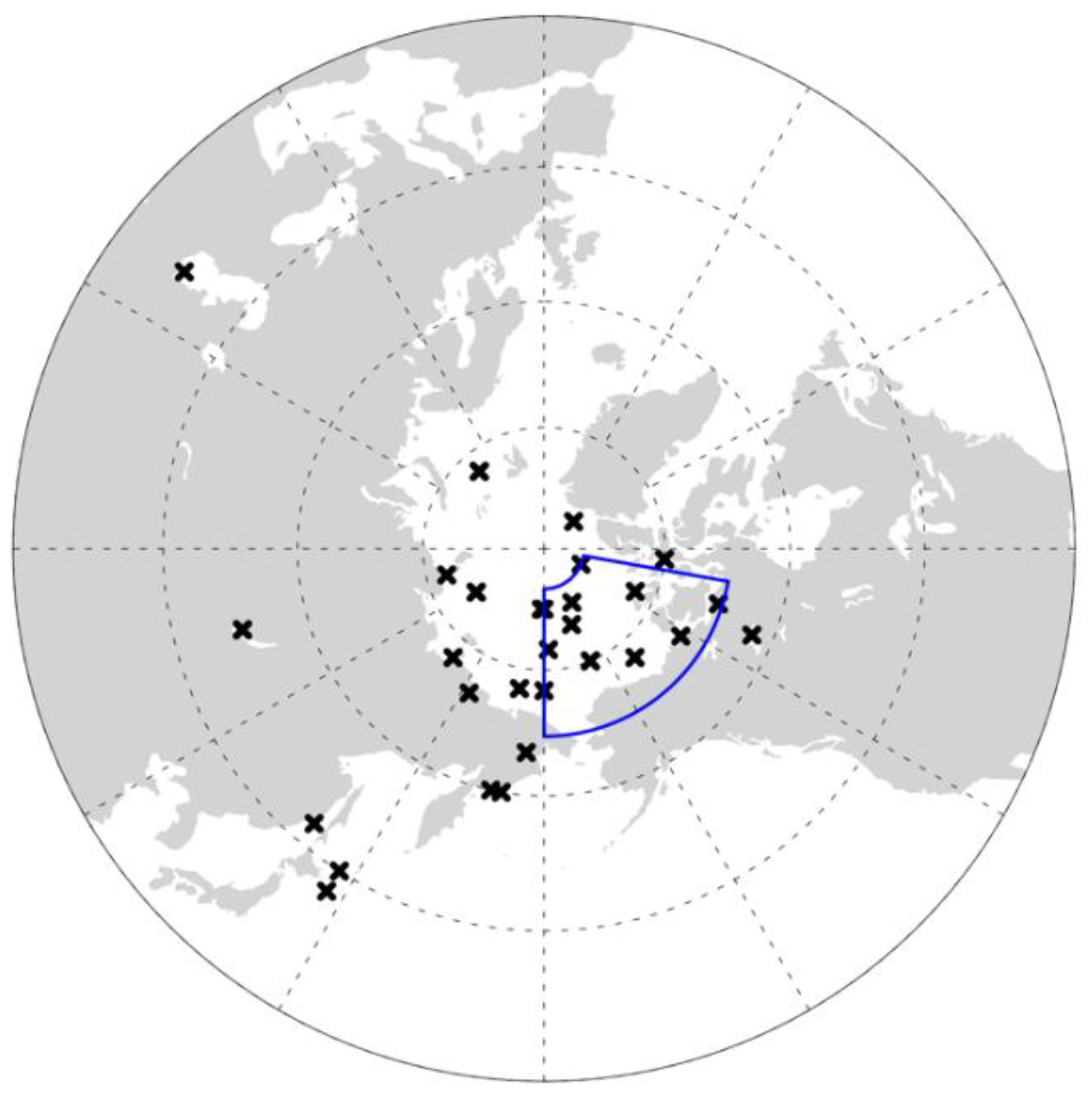


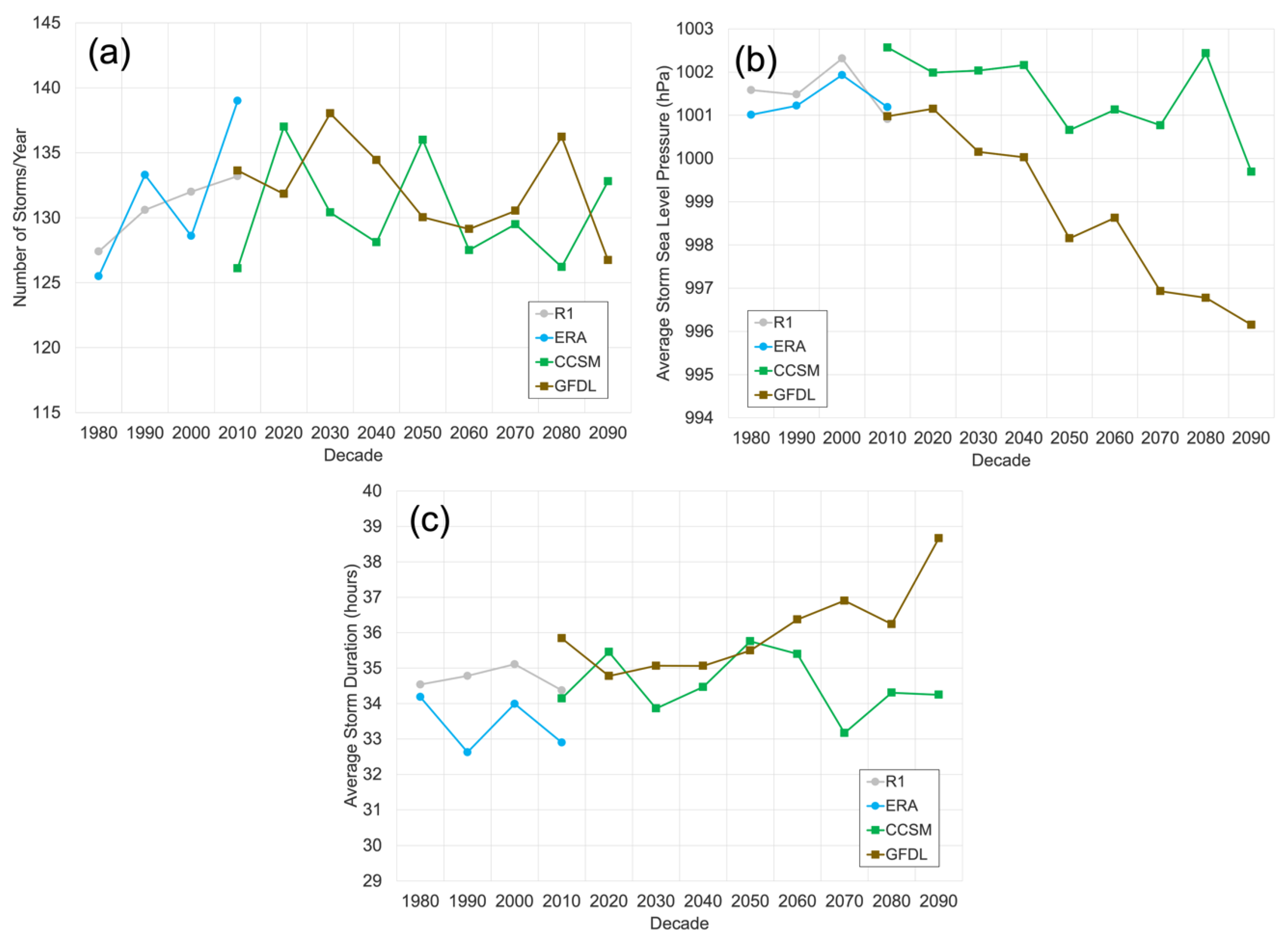
| Date | Water Level | Wind Speed | Wind Direction | Storm Central Pressure | Storm Duration |
|---|---|---|---|---|---|
| 11 August 2000 | 1.37 | 17.8 | 271 | 993.4 | 48 |
| 30 July 2003 | 1.26 | 22.1 | 285 | 975.9 | 42 |
| 9 October 2002 | 1.15 | 983.3 | 120 | ||
| 31 July 2008 | 1.12 | 18.8 | 251 | 982.6 | 72 |
| 15 August 2002 | 1.12 | 20.8 | 290 | 979.8 | 36 |
| 26 February 2011 | 1.05 | 17.6 | 269 | 977.1 | 12 |
| 5 August 2003 | 1.04 | 16.6 | 291 | 987.5 | 36 |
| 18 July 2016 | 1.02 | 23.9 | 262 | 990.5 | 78 |
| 11 November 2013 | 1.00 | 15.3 | 242 | 971.1 | 54 |
| 30 September 1994 | 1.00 | 16.0 | 233 | 1003.1 | 228 |
| 31 July 2004 | 0.98 | 998.9 | 30 | ||
| 1 September 2018 | 0.98 | 985.1 | 18 | ||
| 5 January 2017 | 0.96 | 17.5 | 252 | 992.4 | 60 |
| 6 October 2002 | 0.94 | 19.8 | 257 | 984.0 | 54 |
| 19 September 2016 | 0.94 | 12.7 | 277 | 982.4 | 108 |
| 16 August 1997 | 0.93 | 18.9 | 276 | 988.6 | 12 |
| 6 January 2004 | 0.91 | 22.3 | 243 | 1002.0 | 30 |
| 18 August 1994 | 0.89 | 976.9 | 36 | ||
| 16 December 2008 | 0.88 | 12.2 | 183 | 999.1 | 42 |
| 25 July 2003 | 0.87 | 18.1 | 235 | 983.3 | 72 |
| 25 July 2017 | 0.87 | 996.7 | 48 |
Publisher’s Note: MDPI stays neutral with regard to jurisdictional claims in published maps and institutional affiliations. |
© 2022 by the authors. Licensee MDPI, Basel, Switzerland. This article is an open access article distributed under the terms and conditions of the Creative Commons Attribution (CC BY) license (https://creativecommons.org/licenses/by/4.0/).
Share and Cite
Bieniek, P.A.; Erikson, L.; Kasper, J. Atmospheric Circulation Drivers of Extreme High Water Level Events at Foggy Island Bay, Alaska. Atmosphere 2022, 13, 1791. https://doi.org/10.3390/atmos13111791
Bieniek PA, Erikson L, Kasper J. Atmospheric Circulation Drivers of Extreme High Water Level Events at Foggy Island Bay, Alaska. Atmosphere. 2022; 13(11):1791. https://doi.org/10.3390/atmos13111791
Chicago/Turabian StyleBieniek, Peter A., Li Erikson, and Jeremy Kasper. 2022. "Atmospheric Circulation Drivers of Extreme High Water Level Events at Foggy Island Bay, Alaska" Atmosphere 13, no. 11: 1791. https://doi.org/10.3390/atmos13111791
APA StyleBieniek, P. A., Erikson, L., & Kasper, J. (2022). Atmospheric Circulation Drivers of Extreme High Water Level Events at Foggy Island Bay, Alaska. Atmosphere, 13(11), 1791. https://doi.org/10.3390/atmos13111791








